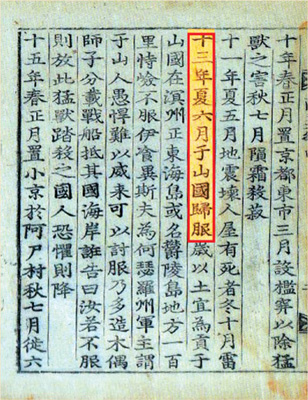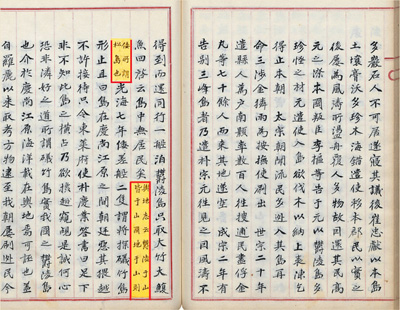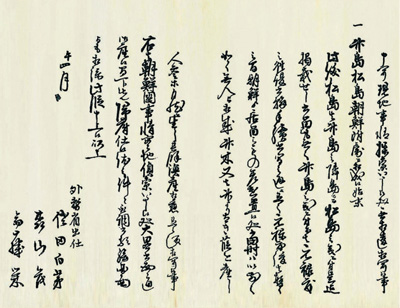- Dokdo in the East Sea
- Educational material
- Elementary Student Version
Dokdo in the East Sea
Table of Contents Open Contents
2. Knowing Dokdo’s History
After listening to his teacher’s lesson, Seung-ju looked for Japan’s erroneous claims in varioushistorical records.
As he was studying these historical records he learned the fact that a long time ago the name “Usan” was used instead of Dokdo.
In addition to Usan (于山), Dokdo has also been called Cheonsan (千山), Jasan (子山), Dokseom, and Sukdo.
Korea’s evidence
| Evidence | Contents |
|
Samguk sagi(History of the Three Kingdoms, compiled in 1145)
Usan-guk was a kingdom that controlled Ulleungdo and Usan (Dokdo). It is recorded that during the reign of King Jijeung of Silla, General Kim Isabu conquered Usan and incorporated it into the Silla kingdom. | |
|
“Sejong sillok jiriji” (The Annals of King Sejong Geographical Records, compiled in 1454)
The two islands of Usan (于山) and Mureung (武陵) are located in the center of the East Sea. The two islands are not far from each other, and one can be seen the other island on a clear day. During the Three Kingdoms era, they were called Usan. |
| Evidence | Contents |
|
Sinjeung Dongguk yeoji seungnam (New and Expanded Complete Conspectus of the Territory of the Eastern Country; compiled in 1530)
Ulleungdo and Usando are explained in detail in the Gangwon-do, Uljin County section, showing that they are certainly part of Korean territory. | |
|
An investigation report from 1696 related to An Yong-bok
A report on An Yong-bok’s second visit to Japan states that Jukdo (Ulleungdo) and Songdo (Dokdo) are both recorded in Japanese documents as being part of Gangwon-do (Korean territory). | |
|
Mangi yoram (Essentials of Governance) (1808)
Statements such as “Both Ulleungdo and Usando are Usan’s land,” clearly show that both islands are Korean territory. |

According to historical records, Silla ruled Usan, and Dokdo, being a sister island of Ulleungdo, was part of Usan’s territory. Therefore, Dokdo has been Korean land since the Three Kingdoms period.

■ Let’s fill in the details below based on Samguk sagi (History of the Three Kingdoms), The Annals of King Sejong Geographical Records, Sinjeung Dongguk yeoji seungnam, and Mangi yoram.
General Yisabu, general under King Jijeung (512 AD) annexed Usando for the Silla Kingdom. Usan/Usando is now called ( ).
■ See if you can fill in the blank with the date Dokdo became Korean territory.
Dokdo has been Korean territory since at least ( ).
○ Let’s find Dokdo on an old map of Korea.

>"Dongguk jeondo” (Complete Map of the Far East) compiled by Jeong Sang-gi (eighteenth century)
On this eighteenth century map Ulleungdo and Usan are both labeled!
On old maps, Dokdo is labeled as Usando and Usando and Ulleungdo both appeared as Korean territory.
On this map from the mid-nineteenth century are written “Ulleungdo” (鬱陵島) and “Usan" (于山)!
“Complete Nautical Map” (mid-nineteenth century)
On this eighteenth century map Ulleungdo and Usan are both labeled!
On old maps, Dokdo is labeled as Usando and Usando and Ulleungdo both appeared as Korean territory.
On this map from the mid-nineteenth century are written “Ulleungdo” (鬱陵島) and “Usan" (于山)!
“Complete Nautical Map” (mid-nineteenth century)

○ Let’s take a look at what country Dokdo is part of according to old Japanese documents and maps.
Japanese evidence
| Evidence | Contents |
|
“Onshū shichō gōki” (“Records on Observations on Oki,” 1667)
This book, written in 1667, was based on Japanese records and is the first book regarding Ulleungdo and Dokdo. It contains the observations of a Japanese official as he looked at Oki Island. In this book it is recorded that Japan’s northern boundary is Oki Island. This statement is an acceptance of Dokdo not being part of Japan. | |
|
“Chōsen-koku kosai shimatsu naitansho” (Confidential Inquiry into the Particulars of Korea’s Relations with Japan; 1870)
In 1869, Meiji government officials from the Ministry of Foreign Affairs were dispatched to Ulleungdo and Dokdo and instructed to investigate whether the islands were part of Korea. This is evidence that at that time Japan recognized Ulleungdo and Dokdo as Korean territory. In addition, a report called “Ulleungdo and Dokdo are Part of Korea” was written, demonstrating Japan’s acceptance of Dokdo as part of Korea. | |
|
Official document sent to the Ministry of Home Affairs of Japan by the Daijōkan[note 008](1877)
In 1877, the Daijōkan, the highest decision-making office in Japan, inquired if Ulleungdo and Dokdo were Japanese territory. Based on the results of this inquiry, the Daijōkan made the final decision that both Ulleungdo and Dokdo had no relation to Japan. |
○ Let’s take a look at this old map of Japan and see what Dokdo is called and which country it is part of.
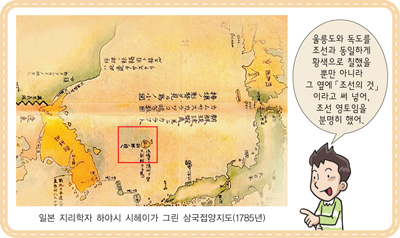
The Japanese geographer Hayashi Shihei’s “Map of the Three Countries” (1785)Ulleungdo and Dokdo are not only colored the same yellow as Joseon, the phrase “Joseon’s (Korea’s) land” is written next to them, clearly indicating that both islands are Korean territory.

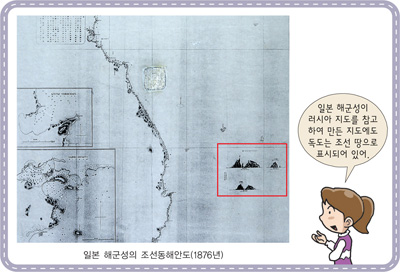
Map of the Eastern Coast of Joseon, compiled by the Japanese Navy(1876)In a map the Japanese Navy made by referring to a Russian map, Dokdo is labeled as Joseon territory.


“Complete Map of Korea," in the appendix of the book True History of the Japanese-Russian War (Nichi-Ro sensō jikki 日露戰爭實記) (1905)In a 1905 map published by Japan, Dokdo is labeled as Korean territory.

■ We just saw Korean and Japanese documents and maps proving that Dokdo is part of Korea. Let’s write down the names of these documents.
| Evidence classification | Evidence | |
| Old document | Korea | Samguk sagi (History of the Three Kingdoms; 1145) |
| Japan | Onshū shichō gōki(“Records on Observations on Oki”; 1667) | |
| Old Map | Korea | Dongguk jeondo(Complete Map of the Eastern Country ; eighteenth century) |
| Japan | Samguk jeobyang jido (Map of the Three Kingdoms ; 1785) | |

From looking at old records and maps, we can see that Japan knew that Dokdo was part of Korea from a long time ago.

○ Let’s check to see if Dokdo is Korean territory according to international law.
International law confirming that Dokdo is Korean land means much. This information can be used to convince the world that Dokdo is part of Korea.
- The Korean Empire proclaimed Imperial Ordinance No. 41 to clarify Dokdo is Korean territory in terms of modern international law in October, 1900.
- On January 29, 1946, the General Headquarters of the Allied Powers returned to Korea territory that Japan had seized. At that time, Article 677 of the United Nations Command Headquarters acknowledged Dokdo as Korean territory and excluded it from Japanese territory.
- On June 22, 1946, the United Nations Headquarters Command, through Article 1033, forbade Japanese fishermen access to Dokdo and the surrounding 12 nautical miles of sea, and confirmed once again that Dokdo is Korean territory.
■ Let’s try to explain international legal evidence that proves Dokdo is Korean territory.
- [note 008]
- Japan’s highest decision-making office; similar to the Uijeongbu (State Council) of Korea’s Joseon government
[note 008]
Daijōkan
Japan’s highest decision-making office; similar to the Uijeongbu (State Council) of Korea’s Joseon government
닫기







